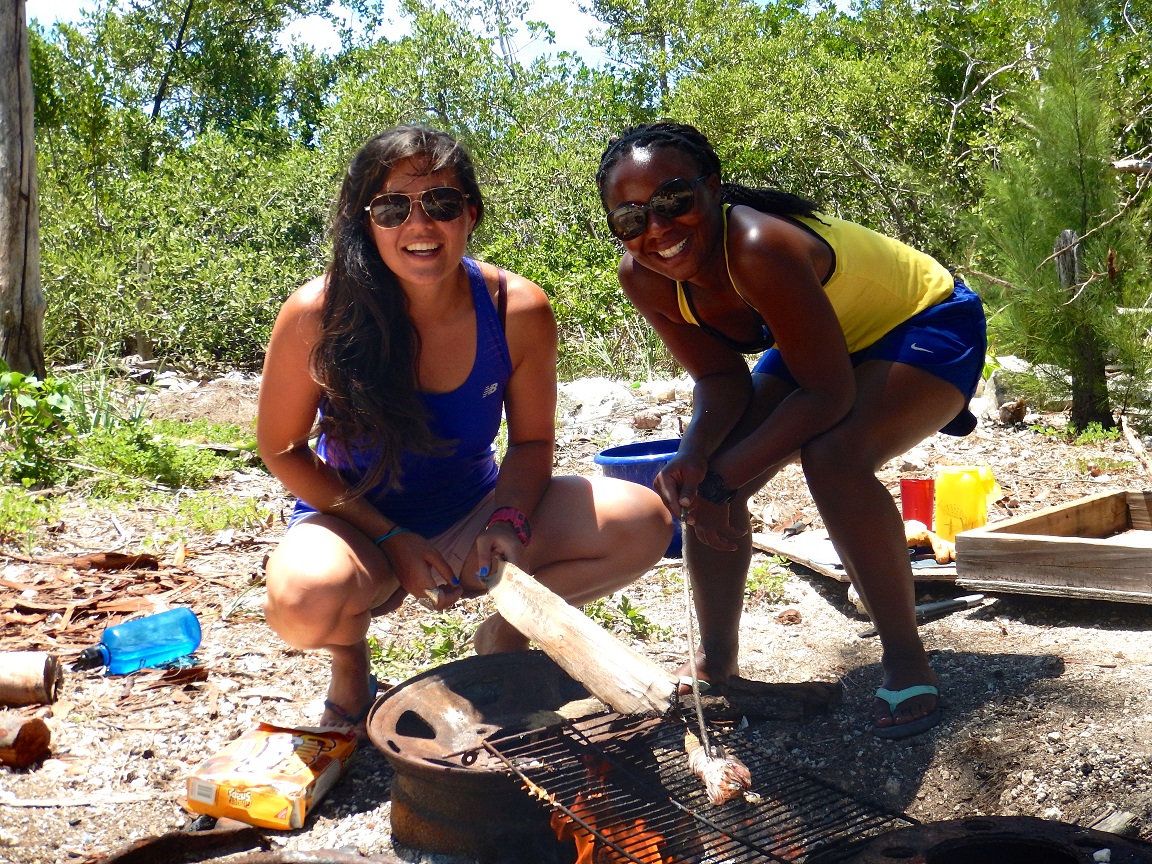Three months ago, the Cape Eleuthera Institute (CEI) welcomed back Simon Fraser University (SFU), and their 2015 field team of seven researchers. Based in British Columbia on the west coast of Canada (with two more collaborators joining them from the University of Bristol, UK), they made the trip down to Eleuthera to continue their research on various aspects of the lionfish invasion in The Bahamas. From acoustics to nutrient dynamics projects, the summerwas a dynamic one for SFU, filled to the brim with scientific escapades. And the most important thing they’ve learned? Every problem can be solved with cinder blocks and cable ties.
May kicked off with an exciting collaboration between the SFU team and Brendan and Sophie Nedelec from the University of Bristol that delved into the effects of lionfish on the acoustics of a coral reef – are reefs with lots of lionfish perhaps quieter than those with fewer or no lionfish? To tackle this question, the team needed more than keen eyes, and their ears certainly weren’t sharp enough to pick up on any differences. Sophie and Brendan came down equipped with a hydrophone, accelerometer, DJ-like switchboard, and a lot of cords that were loaded onto the boat and brought out to patch reefs to take sound recordings during the day and at night (when lionfish are typically hunting).
So what exactly do coral reefs sound like? Well, kind of like frying bacon! It was pretty magical to listen to the cracks of snapping shrimp complimented with the periodic grunt of a fish swimming by. Sophie and Brendan, along with two members of the SFU team, departed at the end of May, but the remaining five researchers were kept busy for the remaining two months, pursuing their questions surrounding the lionfish invasion.
Nicola Smith came down to Eleuthera this summer seeking to answer questions surrounding both the lethal and non-lethal effects of groupers (native predators) on lionfish. In other words: (1) are groupers eating lionfish (lethal), and (2) even if they’re not necessarily a direct predation threat, is it possible that their presence has an indirect, fear-induced effect on lionfish (non-lethal)? In their efforts to address the first question, Nicola and the team could often be found collecting grouper stomachs from the fishermen around Cape Eleuthera. These stomachs will be dissected to see what the grouper are eating, and if there are any lionfish in there!
To look into the non-lethal effects of grouper on lionfish, we kicked off the summer by catching 40 lionfish, and giving them each a unique UV tag to identify them. After these lionfish were distributed across 12 patch reefs (of varying grouper densities), the team conducted dawn and mid-day behavioural surveys for the remainder of the summer. These surveys required (very) early mornings, but by the time the team was in the water at 5am surrounded by bioluminescence, they were pretty happy scientists.
Do prey fish learn to recognize lionfish as a predator with a hungry appetite? If they do, are their antipredator behaviours effective against lionfish? Adrienne Berchtold, an MSc student, spent the summer answering these questions. Her project required catching parrotfish off of high lionfish density and low lionfish density patch reefs throughout the summer. Why the density difference? Adrienne is interested in whether parrotfish from high density reefs have perhaps learned to recognize lionfish as predators and as such are more effective at evading them than parrotfish from low density reefs that may not recognize lionfish as predators and are more susceptible to predation. Adrienne and the team exercised laser concentration and perfect silence as they observed parrotfish behaviour in response to lionfish and grouper (a native predator) during behavioural trials conducted in the CEI labs.
Fiona Francis is interested in nutrient dynamics in tropical marine systems. Fiona spent the summer quantifying how fish aggregations can influence primary production by providing essential nutrients for seagrass and algal growth. To do so, Fiona and the team created 24 cages filled with varying densities of grunts and measured seagrass and algal growth around them. Using 120 cinder blocks, endless yards of mesh and more zip ties than one can count, Fiona and the team created some beautiful “grunt condos”! On days when she wasn’t switching grunts in and out of cages or collecting tiles for processing, Fiona could be found taking over the boathouse with coolers, fish, and a whole lot of Ziploc bags! Part of her project continued from her work last year at CEI involves measuring the nutrients that different species of fish excrete, and to do this she incubated individual fish in bags of seawater for a short period of time. By taking water samples before and after incubation, she is able to look the amounts of phosphorus and nitrogen that each fish excretes. Fiona can then look at the relative nutrient contributions different fish species make to coral reefs. The biggest challenge for the team came when they had to figure out how to measure excretion from a lionfish without them puncturing their bag (hint: it involved A LOT of buckets!).
Back in Canada now, the team is excited to dive (pardon the pun) into their data, and answer the questions they came to CEI with 3 months ago! Field season 2015 was a busy one for SFU, and they couldn’t have pulled it off without the fantastic support of everyone at the Cape Eleuthera Institute – thanks!

